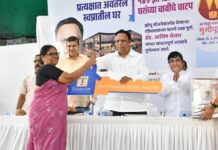Bengaluru, Oct 16, 2015
“Architecture is the thoughtful making of space,” voiced famed American architect, Louis Isadore Kahn. Drawing parallels to this thought, goes the tagline of Mumbai based Rustomjee Group, “It’s Thoughtful. It’s Rustomjee.” Headed by Boman Rustom Irani, as itsChairman and Managing Director, the first generation real estate developer and an entrepreneur with over 18 years of experience, is the driving force behind the successful rise of Mumbai’s major real estate player ‘Rustomjee’. Founded by Irani in 1996, the company has as of 2015, constructed a slew of top-rated residential projects, townships and commercial spaces totaling 10 million sq ft across the Mumbai Metropolitan Region (MMR). There is 15 million sq ft of ongoing development and an estimated 30 million sq ft of future development within the MMR.

Irani is currently the Vice President of the Maharashtra Chamber of Housing Industry (MCHI) that represents over 1,000 leading real estate developers from Maharashtra. He is also the founder and chief benefactor of the ‘Rustom Irani Foundation’ which manages and runs educational institutes ranging from pre-school to post-graduation, catering to more than 12,000 students. In 2008, the Rustomjee Academy for Global Careers (RAGC) was established to skill students in vocational courses like automobile, construction, hospitality, electrical and business trade. RAGC has been awarded A+ Gradation by the Government of Maharashtra and has also won the ‘Best Vocational Training Provider’ award instituted by the UK India British Council and FICCI. Irani has made contribution towards social causes like ‘Homes for All’ and ‘Making Education a Priority’, the top priorities in his life. He is married to the multi-talented Indian actress Perizaad Zorabian since 2006, and is father to two lovely kids.
As part of the panel discussion ‘Realizing the vision 2020 – Relevance to the Indian Framework’ at the 3rd Edition of the Economic Times Architecture & Design Summit held on 11th September 2015 at The Taj West End, Bangalore, Irani was in his element. He quipped, “A developed city is not the one which uses the motorcar, but the developed city is the one where even the rich uses the public transport,” while speaking for the opening keynote address, ‘Transformation 2020 – The broad vision for India’. The summit brought together budding and prominent architects, interior designers, landscape architects, consultants and students on one platform, to enable insightful discussion and effortless interaction amidst attendees.
It was a privilege for The Property Times, the online media partner of the summit, to have Boman Irani talk to its Managing Editor, Altaf Hussain. Here are excerpts from the interesting conversation that ensued between them:
Altaf: At the 3rd A&D Summit, you delivered the Opening Keynote Address on “Transformation 2020: The Broad Vision for India”. Can you summarize the same for our readers?
Boman: The Indian economy is booming and serves as a good growth engine for the country. Now we are all in the best part of India’s history. Yes, 2020 is just 5 years away, but still we can accomplish a lot. There is a call to look at the time window between 2015 – 2035 for India. In the next 20 years there would be 10-20 million jobs created annually. The Government should improve the agricultural economy; provide banking access to the poorest; enhance pan India digital connectivity and, build smart cities or rather smart villages.These smart hotspots will actually be India’s new age temples.
Altaf: Which sector is India’s next opportunity, as the nation grows by leaps and bounds?
Boman: Undoubtedly, it is the construction sector though a lot needs to be done so that it could be regulated. For example in a city like Mumbai, it is terrible to face the reality that 60 per cent of it is built in an unregulated manner. Actually, Mumbai’s private real estate developers have contributed more to city building than the Government. The growth has spilled over to rural India because of the exponential rise in the ownership of mobile phones by the rural populace. Greater communication connectivity coupled with highways and metro transport mushrooming at a rapid pace, means that in India, construction of buildings for a variety of purposes is set to take a quantum leap. The Government’s ambitious ‘Gram Jyothi Yojana’ to ensure power for all homes in India, presents a massive opportunity for the construction industry. It is heartening to note that the present Government is finally listening with all ears, to the Confederation of Real Estate Developers Association of India (CREDAI).
Altaf: With every rise, a fall follows. What should the Indianconstruction industry be wary of?
Boman: Yes, over-ambition to increase the pace of construction development in the country is likely to prove counterproductive. Let’s start moderately. Begin the development job with 100 acres initially, rather than going all out with 500 plus acres everywhere. A good example of over-ambition going wrong is what is happening with China now. Currently, at CREDAI, a realistic study is going on with fresh data being collected and analyzed about supply being greater than demand. Course correction would be the next obvious development. This is bound to happen, as currently in India 24,000 homes are being built per day, though 4,00,000 homes are lying vacant which is actually unsold inventory eating up resources without purpose.
Altaf: Any global trend in the construction industry that can be imitated in India?
Boman: Cities created around tourist and pilgrimage centers across India would be a good option keeping in mind the sustenance of growth and stability of business ventures here.
Altaf: As a leading real estate developer what would be your message to the Government of India?
Boman: The Government should develop policies in association with us in the early stages of policy making itself. That would mean quicker drafting and execution of policies rather than going back and forth with reviews and counter-reviews. Many schemes have failed too, thanks to shoddy ground work during conceptualization of these policies without proper vision and mission. I would prefer that the Government makes policies and aids policies in tandem with us and later move out of the way while we execute. It should create minimum rules and provide maximum governance. Regulators should increase the umbrella of its influence by including more government bodies, civic bodies, private bodies and consumers too, apart from just developers.
Watch this space for Boman Irani’s next thought!
Corporate Comm India (CCI Newswire)



















